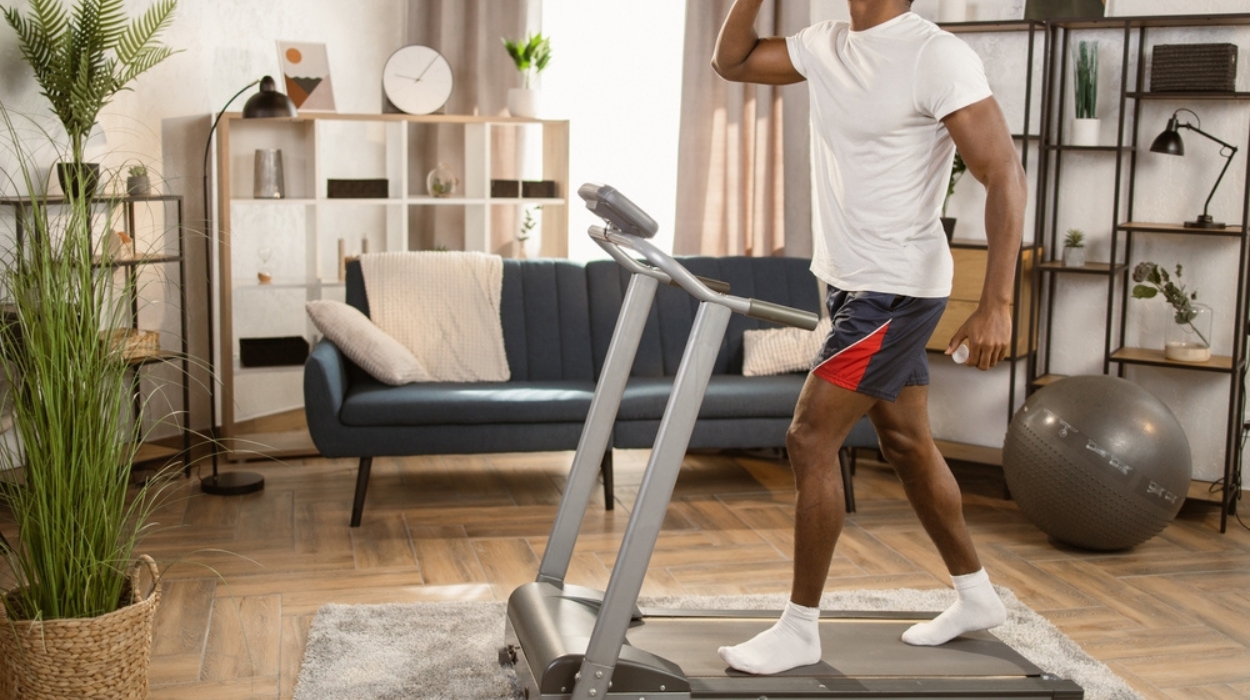
Regular activity is an essential part of maintaining your physical and mental health. As an adult, the World Health Organization[1] recommends at least 150 to 300 minutes of moderate-intensity aerobic exercise each week.
Popular ways to exercise include running, cycling, rowing, and sports. These can be done at any ability level and enjoyed individually or as a group.
As new health and fitness trends develop, different cardio machines continue to gain popularity. Despite this, the treadmill machine still takes the prize for the most popular cardio option among fitness enthusiasts.
A treadmill workout offers a versatile cardio option that uses a simple movement pattern. Developing the proper running form can be achieved fairly quickly with the right guidance.
In this article, we’ve described the different benefits of running on a treadmill in detail. We’ve also discussed the potential drawbacks and how to monitor your progress.
Seven Advantages Of Running On A Treadmill
There are several mental and physical perks. The main ones include:
- Improved running cadence.
- Better cardio health.
- Improved bone and joint health.
- Stress reduction.
- Aids weight loss.
- Offers versatile exercise options.
- Convenient to perform.
Seven Perks Of Running On A Treadmill

Treadmill running is performed using a motorized belt that moves according to your instructions. A console at the front allows you to customize your running variables as needed. Whilst it uses a simple concept, the benefits are wide-ranging.
We’ve discussed the main physical and mental perks of regular performance below.
Improved Running Cadence
Running cadence, also called stride length, is the number of strides you take per minute. In running circles, hitting a certain cadence is suggested to be optimal for performance.
This came from studies examining the cadence[2] of elite-level athletes. Researchers hypothesized that a particular cadence may lead to better performance.
Factors such as height, weight, experience level, terrain, and footwear can influence your cadence. Exercising on a machine provides a neutral surface. With this, you can monitor your cadence[3] over a set distance and change it accordingly.
With enough practice, this can then be transferred to an outdoor running environment.
Better Cardiovascular Health
Performing regular aerobic exercise has consistently been shown to improve cardio health.[4] Cardiovascular workouts such as running with a treadmill helps to improve heart health, pump blood around the body, and improve cardiovascular fitness.
Over time, a consistent routine can reduce the risk factors for heart disease. These include reducing your cholesterol and blood pressure levels.
Performing high-intensity interval training[5] can be a great way to reduce your time commitment. It also provides a good leg workout. Most offer built-in programs that allow you to set your run using customized intervals.
Improved Bone And Joint Health
Compared to outdoor running, a treadmill can provide a lower-impact surface. Most treadmills offer built-in shock absorption software, reducing the impact felt on each stride. This makes running with a treadmill good for athletes recovering from an injury or looking to reduce the amount of high-impact running.[6]
When choosing a treadmill for this purpose, check that it has built-in shock absorption software under the belt.
Stress Reduction

The advantages involve more than just making your butt bigger. Regular performance of activity has been shown to improve mental health[7] including anxiety, depression, sleep quality, and mood. Improving aspects of brain function through running can lead to a better quality of life.
Alongside this, treadmill runs can be used as a social occasion to enjoy exercise with friends. Walk into any gym and you’ll find rows of treadmills lined up together. Exercising as a group and encouraging each other can be a great way to improve your mental health.
Aids Weight Loss
If you’re looking to lose body fat and improve your body composition, maintaining a calorie deficit[8] is essential. Running with a treadmill offers a simple concept that helps to burn calories and produce a bigger deficit. Depending on your duration and intensity, running on a treadmill can burn more calories when performed regularly.
Make sure to complement your aerobic activities with regular resistance training. Performing a dumbbell leg workout followed by a treadmill run is one example of a well-planned session.
Offers Versatile Exercise Options
Unless you’re using a high-tech fitness tracker, running on a treadmill provides a great way to set your pace. Treadmill software allows you to run at a prescribed pace and change it according to your progress. The belt dictates the pace of your run which forces you to keep up with the belt.
Once you’re used to a certain pace, this can then be used to improve your pacing in outdoor events.
Unlike running outdoors, treadmills offer multiple customization options at the push of a button. Most consoles allow you to change your pace and incline as needed. You can also work at a certain heart rate and set the amount of calories you want to burn for a given distance.
Convenient To Perform
Whether you’re at home or in the gym, a treadmill is a convenient piece of equipment. Regardless of the outdoor environment, a treadmill can always be used. If you don’t have electricity, manual ones are often available.
When you finish exercising, you’re in the same position as you started. Even if you need to stop the workout early, you can get off the machine and quickly switch your focus.
Potential Drawbacks
Whilst running with a treadmill offers several benefits, there are also potential drawbacks to consider. To give you a fully transparent viewpoint, we’ve discussed the main ones below.
Work Different Muscle Groups
When running outdoors, you use your quads to push off the floor to step forward. As your legs swing through, you use your hamstrings to bend the knee and finish the stride cycle.[9]
When performing treadmill training, you use a flat and soft surface. This is either powered by a machine or done manually. With this, you see changes in muscle activation compared to overground running.
Due to this, the muscle mechanics differ.[10] Compared to overground running, the degree of muscle activation in your gluteus maximus and vastus lateralis tend to be lower. When treadmill training, you tend to work fewer muscle groups.[11]
Make sure you perform a mix of treadmill training and normal running. The former offers a versatile running option when running outdoors may not be possible. However, they don’t need to be used as the sole cardio option.
Don’t Run On Different Terrains
One of the big considerations when on different surfaces is the impact of running on your knees. Most belts offer a smoother, cushioned belt that can reduce the impact on your knees. For people with joint issues, this makes running with a treadmill a good option alongside outside running.
However, when on different terrains you need to adapt to different surfaces. When doing this, your leg muscles and feet are constantly making small adjustments. With this, running outdoors would also provide more of a core workout for runners. These minor adjustments help you to build coordination and balance when moving.
It May Get Boring
One of the best things about running outdoors is taking in the different environments around you. Whether it’s hot, cold, windy, or rainy, running outdoors offers a different experience each time. Alongside this, research examining different environments has suggested that exercising outdoors can improve your mental health.[12]
Even with a good playlist or a TV in front of you, running indoors on a belt just isn’t the same. Running outdoors provides you with a more natural sense of the distance you are trying to cover. Instead of a belt, you have an obvious start and finish point to focus on.
As technology continues to evolve, most brands now offer a fully immersive experience. Some have large screens and built-in speakers that display different workout environments. Some also offer on-demand trainer-led feedback and scores.
Whilst this helps to close the gap between the different experiences, it still doesn’t replace the feeling of running outdoors. This is why treadmills should be used when needed rather than as the sole option.
How To Monitor Your Progress On The Treadmill
Whether you’re a beginner runner or a seasoned athlete, monitoring your progress can help get the best out of your performance. It can also help to decide how long you should run on the treadmill to achieve a specific goal.
Most are equipped with high-tech consoles and tracking software that monitors every aspect of your performance.
These are some of the main performance aspects that you can track:
- Speed: The pace that you are exercising at.
- Distance: The distance you have covered using the belt.
- Incline: The position of the belt.
- Pace: Your expected time to cover a set distance. This is set in minutes per kilometer or minutes per mile.
- Calories burned: The estimated amount of energy used during your cardio workout.
- Heart rate: The number of times your heart is beating per minute.
Before you start your training, make sure you have clear goals in mind. Decide what you want to achieve. Whether this is to get fitter, lose weight, or improve performance, make sure you have clear goals in mind.
Once you know this, familiarize yourself with the different features and built-in programs. When exercising, most treadmills have a memory feature that allows you to store your previous session.
If yours doesn’t have this, you can also manually record your data in an application or book. This gives you something to compare each of your aerobic sessions.
During exercise, pay attention to the different workout metrics on the front console. Monitor how your speed, pace, and heart rate change over the session and adjust as needed. This will depend on the goals you’ve set yourself at the start.
Make sure to analyze your training data after each session and compare it to your exercise goals. Check your progress with the timeframe set and make any adjustments if necessary. If your goal is weight loss and you’re not burning enough calories, change the workout intensity or volume.
If you’re not hitting a certain heart rate when exercising, adjust the intensity as needed.
Conclusion
Whether you’re running or biking, performing regular physical activity is essential to maintain good mental and physical health. Running with a treadmill offers a versatile exercise option that remains a popular choice among all levels of fitness enthusiasts.
It also benefits your physical and mental health. The main benefits include improving cardio health, helping to reduce stress, and improving cadence. They are also great when exercising outdoors isn’t possible or as an exercise option that’s kinder on your joints.
When monitoring performance, make sure to familiarize yourself with the machine’s features. Set clear goals and monitor your progress using the software available. Compare your cardio exercise performance and make adjustments as needed.
Frequently Asked Questions
When performed regularly alongside a calorie deficit, it can be effective for belly fat loss. The rate of fat loss will depend on the amount and intensity of exercise alongside the size of the calorie deficit.
Aim to run for at least 30 minutes each time you use the machine. Different exercise modes such as interval training can be used. The perfect amount of time depends on your workout goals and lifestyle.
The effectiveness of using the machine for 30 minutes depends on your exercise goals and dietary intake. For fat loss, this depends on the size of your calorie deficit. For general health, this may be enough when performed regularly.
The ideal pace varies between individuals. Ability level will determine the difficulty of a chosen pace. Build up to a challenging pace that you can perform for at least 30 minutes. Ensure it creates the required calorie deficit.
Resources
- World (2022). Physical activity. [online] Who.int. Available at: https://www.who.int/news-room/fact-sheets/detail/physical-activity.
- Burns, G.T., Zendler, J.M. and Zernicke, R.F. (2019). Step frequency patterns of elite ultramarathon runners during a 100-km road race. Journal of Applied Physiology, [online] 126(2), pp.462–468. doi:https://doi.org/10.1152/japplphysiol.00374.2018.
- Christine Martin Morgan and Vincent, H.K. (2017). Manipulating Cadence for Gait Re-training in Runners. Current Sports Medicine Reports, [online] 16(6), pp.381–381. doi:https://doi.org/10.1249/jsr.0000000000000414.
- Pinckard, K., Baskin, K.K. and Stanford, K.I. (2019). Effects of Exercise to Improve Cardiovascular Health. Frontiers in Cardiovascular Medicine, [online] 6. doi:https://doi.org/10.3389/fcvm.2019.00069.
- Muhammed Mustafa Atakan, Li, Y., Şükran Nazan Koşar, Hüseyin Hüsrev Turnagöl and Yan, X. (2021). Evidence-Based Effects of High-Intensity Interval Training on Exercise Capacity and Health: A Review with Historical Perspective. International Journal of Environmental Research and Public Health, [online] 18(13), pp.7201–7201. doi:https://doi.org/10.3390/ijerph18137201.
- Warden, S.J., Davis, I.S. and Fredericson, M. (2014). Management and Prevention of Bone Stress Injuries in Long-Distance Runners. Journal of Orthopaedic & Sports Physical Therapy, [online] 44(10), pp.749–765. doi:https://doi.org/10.2519/jospt.2014.5334.
- Aditya Mahindru, Patil, P. and Agrawal, V. (2023). Role of Physical Activity on Mental Health and Well-Being: A Review. Cureus. [online] doi:https://doi.org/10.7759/cureus.33475.
- Ju Young Kim (2021). Optimal Diet Strategies for Weight Loss and Weight Loss Maintenance. Journal of obesity & metabolic syndrome, [online] 30(1), pp.20–31. doi:https://doi.org/10.7570/jomes20065.
- Pariyaporn Phothirook, Sugalya Amatachaya and Punnee Peungsuwan (2023). Muscle Activity and Co-Activation of Gait Cycle during Walking in Water and on Land in People with Spastic Cerebral Palsy. International Journal of Environmental Research and Public Health, [online] 20(3), pp.1854–1854. doi:https://doi.org/10.3390/ijerph20031854.
- Morteza Yaserifar and Anderson Souza Oliveira (2022). Surface EMG variability while running on grass, concrete and treadmill. Journal of Electromyography and Kinesiology, [online] 62, pp.102624–102624. doi:https://doi.org/10.1016/j.jelekin.2021.102624.
- Singh, G., Gaurav Kushwah, Singh, T., Ramírez-Campillo, R. and Thapa, R.K. (2022). Effects of six weeks outdoor versus treadmill running on physical fitness and body composition in recreationally active young males: a pilot study. PeerJ, [online] 10, pp.e13791–e13791. doi:https://doi.org/10.7717/peerj.13791.
- Lahart, I., Darcy, P., Gidlow, C. and Calogiuri, G. (2019). The Effects of Green Exercise on Physical and Mental Wellbeing: A Systematic Review. International Journal of Environmental Research and Public Health, [online] 16(8), pp.1352–1352. doi:https://doi.org/10.3390/ijerph16081352.




